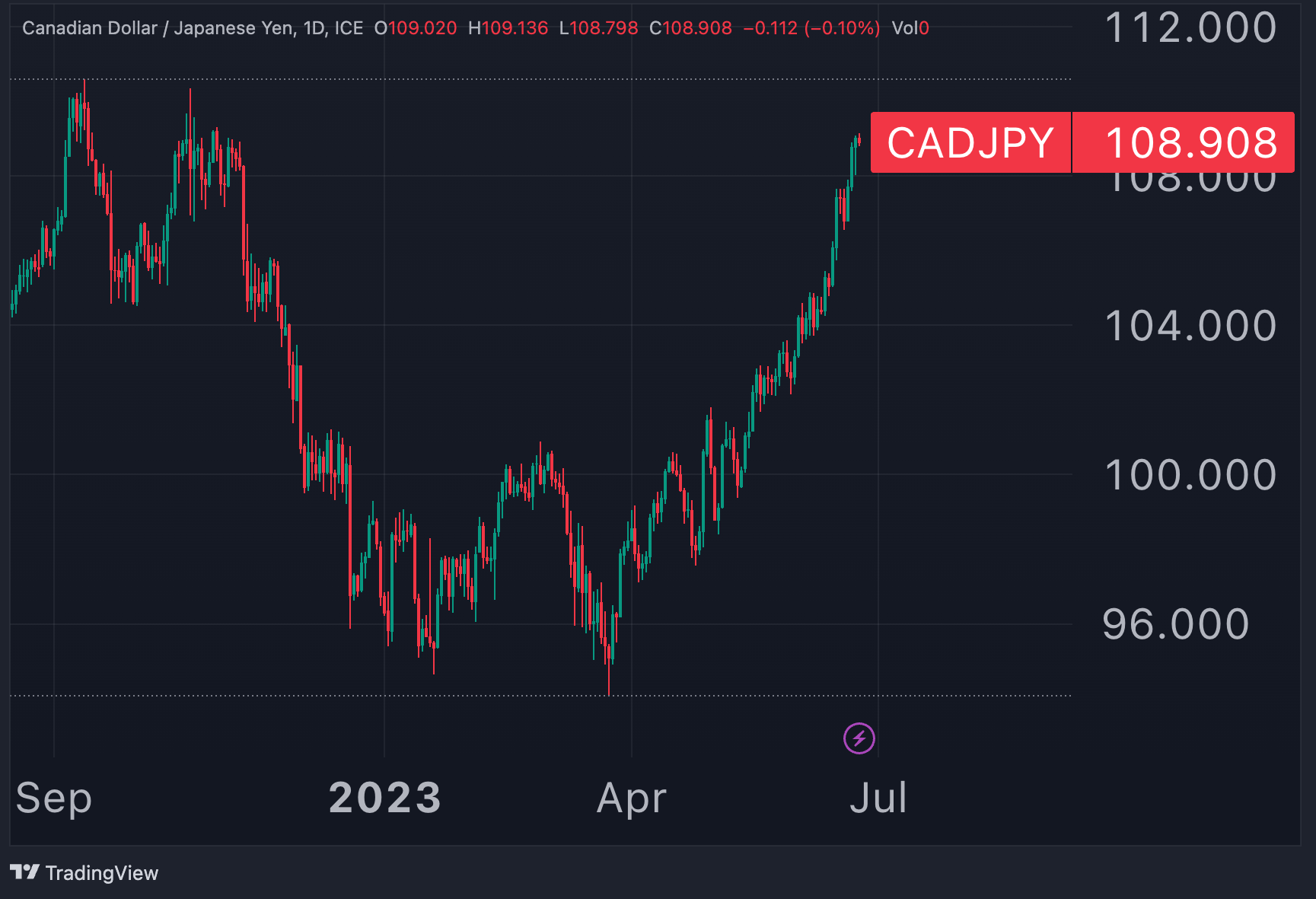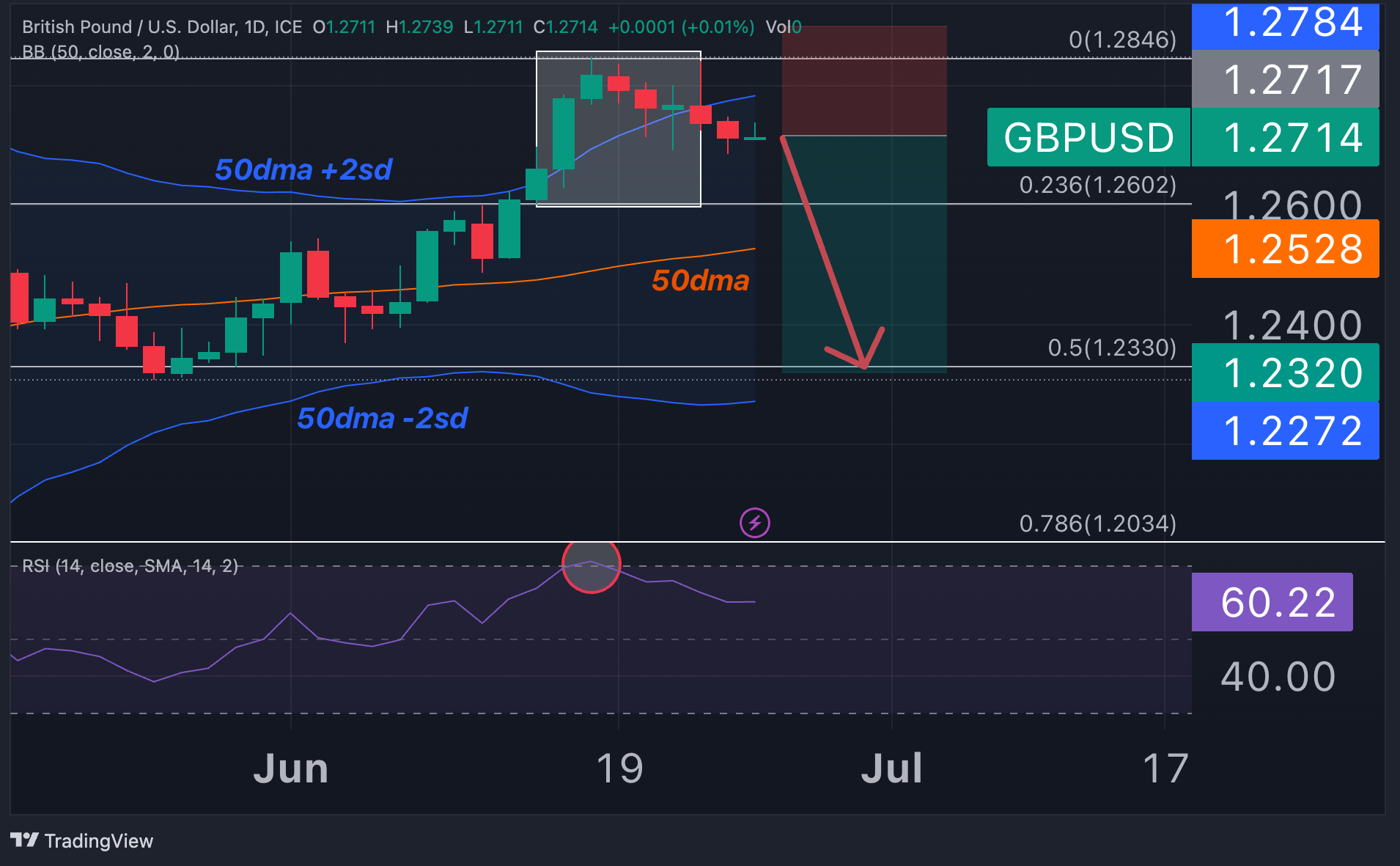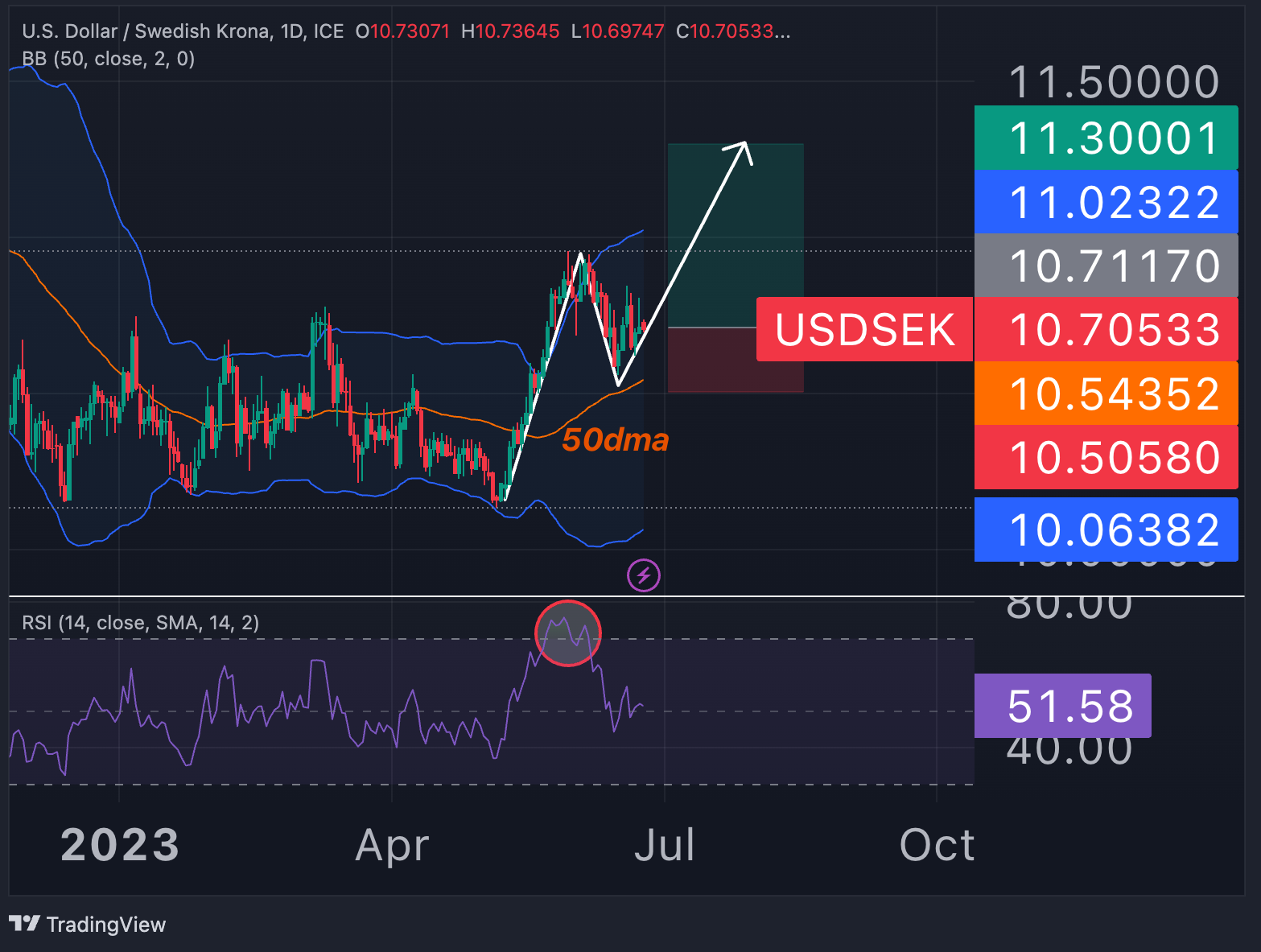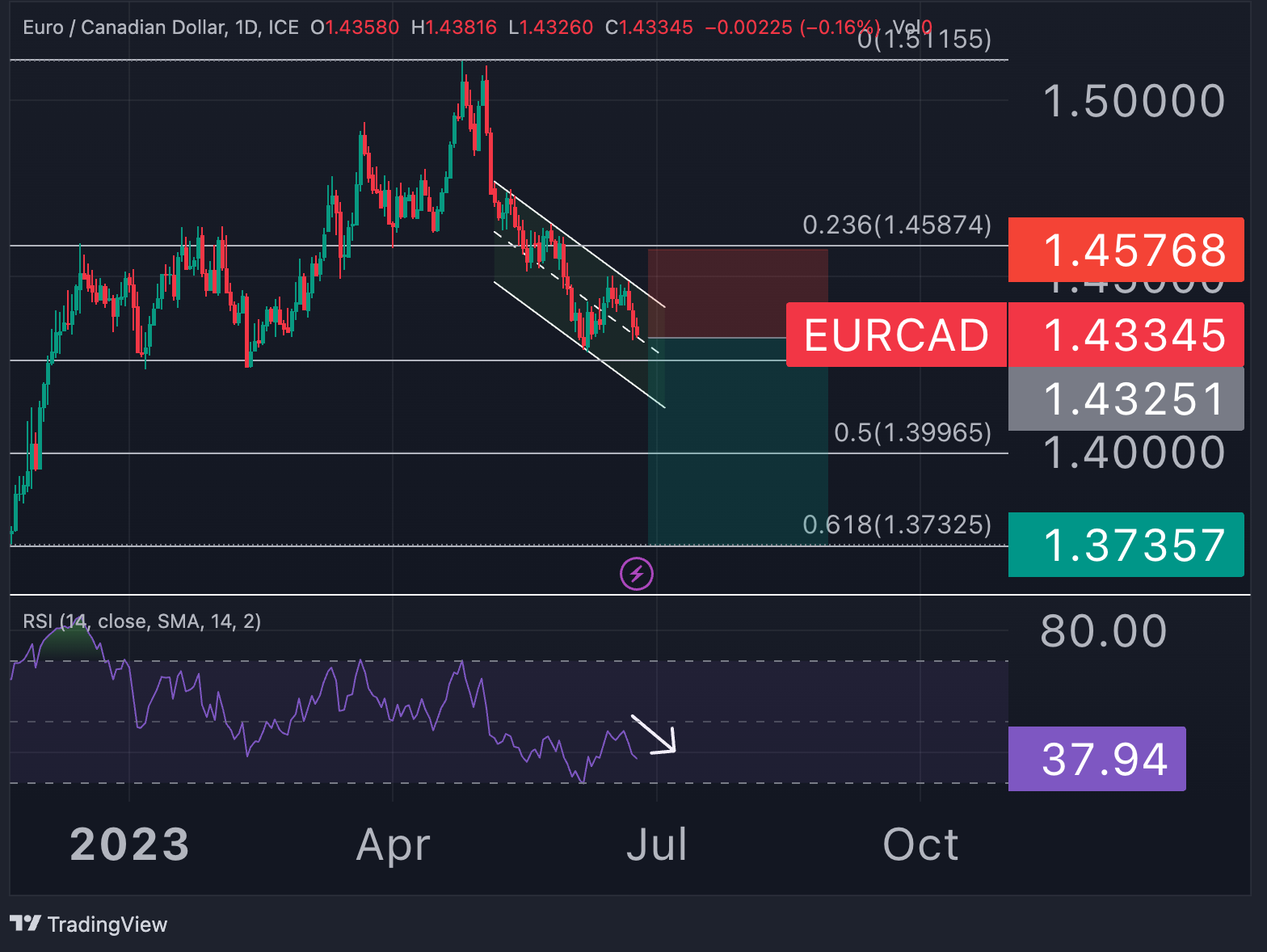Market Review: What Happened Last Week
Jerome Powell awoke dollar bulls when he testified before Congress that two more rate hikes this year are a reasonable expectation, while macroeconomic data continues to demonstrate the resilience of the U.S. economy. Markets now anticipate a Fed raise in July, with slightly more than 70% probability.
In Europe, however, the boom cycle is beginning to ebb, with manufacturing output dropping substantially and service activity expanding but at a slower rate than predicted. The euro lost 0.5% last week, ending a two-week winning streak.
The Canadian dollar (CAD) was the top performing currency last week, rising versus every other major currency and gaining 0.3% against the US dollar.
The Australian dollar (AUD) was the primary laggard among major currencies, losing nearly 3% of its value versus the USD and achieving its worst weekly performance since August 2022, as the RBA signaled the end of rate hikes.
Overall risk appetite has cooled, with the US stock market reporting its first week in the red after more than a month-long rally.
On the commodities market, the internal tensions in Russia, which were resolved over the weekend, have had no effect on oil prices, at least for the time being, while natural gas prices have returned to levels not seen since the start of March. Gold and silver weakened amid hawkish Fed remarks and a rebound in the greenback.
Forex Market: What To Expect This Week
This week's focus will be on central bank speakers, who will most likely maintain the hawkish tone of the previous week.
From June 26 to 28, the European Central Bank will hold its annual forum in Sintra, Portugal. "Macroeconomic stabilization in a volatile inflation environment" is the theme of the 2023 ECB Forum. On Monday, ECB Governor Christine Lagarde will make her opening remarks. Speakers will include representatives from the Fed (Powell), the BoE, the ECB, Norges Bank, and the Bank of Canada, among others.
Durable goods orders, initial unemployment claims, GDP, personal income and spending, Chicago PMI, final print of University of Michigan sentiment and Core PCE will all be released in the United States.
The euro will be influenced by the June inflation figures, which are expected to fall to 5.6% from 6.1% in May. If inflation falls more than predicted, the euro will face substantial downward pressure, putting an end to the ECB's risk of overtightening after economic activity data has already disappointed.
Chart of the week: Canadian dollar at its highest since late 2022 against the yen

New Trades For The Week
Short GBP/USD: Opened at 1.2727; Take Profit at 1.233; Stop Loss at 1.29; Risk-reward ratio of 2.17

The British pound failed to rally following the Bank of England's larger-than-expected raise, confounding bulls who anticipated for an extension of the uptrend.
GBP/USD has risen roughly 8% since its March 2023 lows, but it may be entering a fresh bearish phase due to a hawkish Fed and growing risk aversion in global markets.
We like to go short on cable at these levels, as the recent uptrend appears to be reversing. Last week, the bearish signal was supplied when the GBP/USD fell after reaching overbought RSI levels and breaking the Bollinger band by two standard deviations from the 50-day moving average.
This could indicate that the bulls' strength has been depleted, allowing the bears to gain ground.
We aim for a bearish extension to 1.232, which is a 50% retracement of the range between the highs and lows in 2023 and is also close to the -2sd of the 50dma Bollinger band.
If GBP/USD recovers from here, the stop loss can be placed at 1.29, to avoid running the risk of a bullish flag formation.
Long USD/SEK: Opened at 10.71; Take Profit at 11.30; Stop Loss at 10.5; Risk-reward ratio of 2.86

On Thursday this week, the Swedish krona (SEK) awaits the Riksbank policy meeting.
The market anticipates a 25-basis-point increase to 3.75%, indicating a slowing in the pace of hikes.
Although inflation is gradually declining, it remains high (9.7% in May), and the economy is showing symptoms of a significant downturn. The manufacturing sector has contracted for ten months in a row and at the fastest pace since May 2020, while the services sector has stalled.
Even if the Riksbank indicates further hikes in September, the SEK is definitely moved by a weakening economic momentum going forward, which may keep the currency at the mercy of bears.
Technically, we saw the onset of a bullish flag pattern when USD/SEK retraced marginally from the May-early June advance on overbought RSI before rallying back again last week.
We target USD/SEK to rise to 11.30, which corresponds to the extension of the first flagpole. The stop loss level can be set slightly below the 50dma at 10.50.
Short EUR/CAD: Opened at 1.4340; Take Profit at 1.372; Stop Loss at 1.458; Risk-reward ratio of 2.34

We stated a few weeks ago that the Canadian dollar (CAD) was our favorite major currency heading into the summer, and the Loonie has performed exactly as expected.
We feel that the Canadian dollar's upward momentum will continue, and we are tempted by the possibility of going short in EUR/CAD and riding on the current short-term downtrend.
The Bank of Canada has resumed hiking rates after pausing and CAD bulls now see the BoC following in the Fed's hawkish footsteps.
The recovery in natural gas energy prices is a further positive driver for commodity-linked CAD.
This week, both the euro and the Canadian dollar will be influenced by statements from members of their respective central banks, as well as inflation data.
Annual inflation in Canada is predicted to dip to 3.4% in May from 4.4% in April. A higher-than-expected result would definitely be bullish for CAD, which is now additionally supported by positive real rates following the BoC's decision to raise the policy rate to 4.75%.
Inflation in the eurozone is expected to dip from 6.1% to 5.6% in June. Lower or higher-than-expected figures could elicit negative or positive reactions against the euro, but we feel the risk has shifted to the downside given the recent slowing in economic growth.
Momentum is bearish, as indicated by the declining RSI, and we are aiming for EUR/CAD to reach 1.3735 in the coming weeks, which would be a 61.8% retracement of the range between highs and lows over the last year.
The stop loss level is set at 1.4587, should EUR/CAD bounce back to the 23.6% Fibonacci level.
Open trades from past weeks:
- Long CHF/JPY: Opened on June 19 at 158.58; Take Profit at 171.62; Stop Loss at 152.5; P&L current +0.8%.
- Short NZD/CAD: Opened on June 19 at 0.8205; Take Profit 0.79; Stop Loss 0.8320; P&L +1.35%
- Long USD/MXN: Opened on June 12 at 17.30; Take Profit 18.50; Stop Loss 16.45; P&L -0.9%.
- Short NZD/USD: Opened on June 12 at 0.6142; TP 0.59; SL 0.62.5; P&L +0.2%.
- Long CAD/CHF: Opened on June 12 at 0.6776; TP 0.7055; SL 0.6650; P&L +0.4%.
- Short EUR/NOK: Opened on June 5, at 11.7969; TP 11.25; SL 12; P&L -0.3%.
- Long USD/CHF: Open on May 30, at 0.9030; TP at 0.94, SL 0.89; P&L -0.8%.
- Short XAG/USD: Opened on May 16, at $23.88; TP $22; SL $24.9; P&L +4.8%.
- Long WTI spot: Opened on May 16 at $70.8; TP $80; SL $66.3;
P&L -2.5%. - Long EUR/JPY: Opened on May 8, at 149.16, TP 160; SL 142; P&L +4.5%.
All About Forex Trading at FlowBank is your gateway to understanding forex market dynamics, trading strategies, risk management techniques, and much more. Whether you're a novice trader seeking foundational knowledge or an experienced trader aiming to refine your skills, FlowBank's resources will empower you to navigate the forex market successfully.




